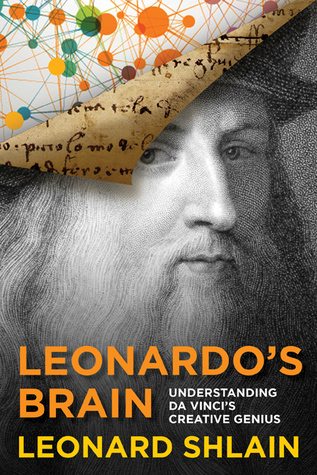Leonardo’s Brain: Understanding Da Vinci’s Creative Genius
The story behind the making of Shlain’s “magnum opus” is as fascinating as the inner workings of this final book itself. In addition to his other best sellers: Art and Physics, The Alphabet Versus The Goddess, and Sex, Time, and Power, Leonard Shlain earned a reputation as an inventor and a surgeon. He died at the age of seventy-one from brain cancer in May 2009. He passed away only after doggedly completing the manuscript, determined to leave behind his boldest and most controversial insights.
While this particular work is not a biography of Leonardo Da Vinci, Schlain highlights portions of Leonardo’s life work to establish a baseline for known genius in order to make comparisons. A prerequisite of fifteenth century European art and science history is not absolutely necessary, but the author only scratches the surface of the rich background so as to establish his initial point that Leonardo was five hundred years ahead of his time. “No other individual in the known history of the human species attained such distinction both in science and art as the as the hyper-curious, undereducated, illegitimate country boy form Vinci.”
Shlain goes to great lengths in an effort to set the record straight on many of Leonardo’s overlooked scientific discoveries and developments which cover as broad a spectrum as the genius’s artistic accomplishments. This litany of “firsts” distract somewhat from the primary objective of the book, but is forgivable because so many of Leonardo’s accomplishments in the field of science have gone unrecognized.
In conjunction with the mini-biography of Leonardo, the author spends a third of the book educating us on the nuances of left-brain, right brain neurology, made famous by Noble Laureate, Roger Sperry. The primary focus of Shlain’s work pertains to the human brain’s communication system between these two very different hemispheres, a stretch of gray matter labeled the corpus callosum. Here, the author brings to light a number of keys to the mysteries of the way humans think about everything from art, sex, war, and politics. Yet, the method Shlain employs to teach us through the mind of Leonardo transforms a boring medical journal into a bonafide page-turner that laymen can understand.
The importance of Shlains’s end of life research offers us hopeful foundations that we can build upon in the areas when neurology and psychology meet. Now, not only are we able to study the effects of a stroke with a clearer idea of how to counteract the damage, we understand the differences in basic personality types. “The most dichotomous brain–that is where the two hemispheres are the most specialized–belongs to a right-handed heterosexual male”.
Perhaps because Shlain was dying when he wrote this, he leaps unwaveringly into a realm that most experts tend to ignore; the arena of the unexplained mental phenomena we leave to science fiction writers. Exactly how did Leonardo write with such vivid detail about places he had never traveled? How was he able to map whole rivers as if gazing down from a satellite, when no apparatus existed for viewing at that height in the fifteenth century? Shlain delves into these questions with forward looking anticipation: “Leonardo’s brain was so complex that it had significant implications for the human species.”
Although Shlain does not specifically refer to the to the PEAR experiments compiled at Princeton University and published in The Margins of Reality by Robert C. Jahn and Brenda J. Dunne, he cites other sources of unexplained space-time mysteries and then re-examines Leonardo. “The inexplicable wizardry present in both his art and is science can be pondered only by stepping back and asking: Did he have mental faculties that differed merely in degree or did he experience a form of cognition qualitatively different from the rest of us?”
In some regard, Shlain leaves us with more questions about ourselves and the world in which we live than he supplies answers.
| Author | |
|---|---|
| Star Count | 4/5 |
| Format | Hard |
| Page Count | 240 pages |
| Publisher | Globe Pequot Press |
| Publish Date | 2014-Oct-21 |
| ISBN | 9781493003358 |
| Bookshop.org | Buy this Book |
| Issue | January 2015 |
| Category | Biographies & Memoirs |
| Share |








Reviews
There are no reviews yet.